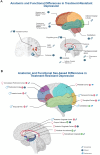Mechanisms Underlying Treatment-Resistant Depression: Exploring Sex-Based Biological Differences
- PMID: 40903897
- PMCID: PMC12409105
- DOI: 10.1111/jnc.70215
Mechanisms Underlying Treatment-Resistant Depression: Exploring Sex-Based Biological Differences
Abstract
Treatment-resistant depression (TRD) represents a severe and complex subtype of major depressive disorder (MDD), affecting approximately 30% of patients who fail to respond adequately to multiple standard antidepressant therapies. While the pathophysiology of TRD remains incompletely understood, emerging evidence suggests that sex-based biological differences might influence its onset, progression, and treatment response. Women are disproportionately affected by depression and are more likely to experience residual symptoms and treatment resistance, potentially due to hormonal fluctuations, immune system differences, and variations in brain circuitry and neuroplasticity. This narrative explores the current literature on the mechanisms underlying TRD, with a particular emphasis on sex-specific biological factors. Key focus areas include dysregulation in neurotransmitters and neurotrophic pathways, inflammation, HPA axis alterations, mitochondrial dysfunction, as well as the influence of sex hormones such as estrogen and progesterone. By highlighting these differences, this review underscores the importance of personalized, sex-informed approaches in the prevention and treatment of TRD and calls for further research to elucidate the biological underpinnings that contribute to sex disparities in treatment outcomes.
Keywords: BDNF: Inflammation; estrogen; metabolism; sex differences; treatment‐resistant depression.
© 2025 The Author(s). Journal of Neurochemistry published by John Wiley & Sons Ltd on behalf of International Society for Neurochemistry.
Conflict of interest statement
J.Q. has a clinical research support relationship with LivaNova; is a member of the speaker bureau with Myriad Neuroscience and AbbVie; is a consultant for EMS, Libbs, and Eurofarma; is a stockholder at Instituto de Neurociencias Dr. Joao Quevedo; and receives copyrights from Artmed Editora, Artmed Panamericana, and Elsevier/Academic Press. The other authors declare no conflicts of interest.
Figures


References
-
- Allen, A. P. , Naughton M., Dowling J., et al. 2015. “Serum BDNF as a Peripheral Biomarker of Treatment‐Resistant Depression and the Rapid Antidepressant Response: A Comparison of Ketamine and ECT.” Journal of Affective Disorders 186: 306–311. - PubMed
Publication types
MeSH terms
Substances
Grants and funding
LinkOut - more resources
Full Text Sources

